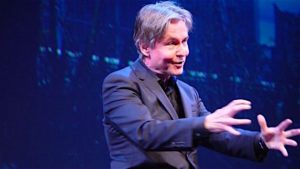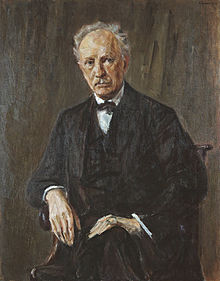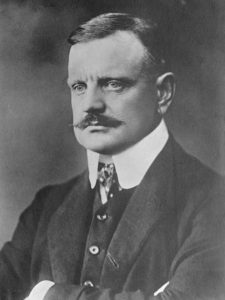A completely full house at Davies Symphony Hall, January 19, 2019, greeted Esa-Pekka Salonen with applause and cheers before he even reached the podium. This was his first performance with the San Francisco Symphony after being named Michael Tilson Thomas’ successor as Music Director of the SFS. Although he had led the orchestra previously, there was a feeling in the house that this was something different, a time to listen and watch intently for hints of what is ahead for San Francisco.
 Esa-Pekka Salonen addressing the SF audience at the Sound Box
Esa-Pekka Salonen addressing the SF audience at the Sound Box
The program featured Also sprach Zarathustra, by Richard Strauss (1896) and Four Legends from the Kalevala, by Jean Sibelius (1896). The West Coast Premiere of Metacosmos Anna Thorvaldsdottir (2017) opened the concert.
Also sprach Zarathustra (Thus Spoke Zarathustra) is familiar to many as the theme music of the movie, 2001: A Space Odyssey which opened in 1968. Being the theme of a hugely popular movie has pluses and minuses. On the plus side is the immense, world wide audience now exposed to the music. On the possibly negative side is the permanent association of the movie and the music making it difficult to think of one without the other. 2001, tragically, now has other associations, as does 1968, a year of war, assassinations, political turmoil. The SF Symphony’s performance of the thrilling music was so effective that the audience was totally involved and could not have pondered anything else. R. Strauss took a work by Friedrich Nietzsche as his inspiration for the music. Nietzsche had as his inspiration Zarathustra, a Persian philosopher from the 6th century B.C.E. After isolating himself from society, Zarathustra sees a sunrise and realizes he must rejoin his world. R. Strauss wrote that he intended his music to transmit “the evolution of the human race from its origin.” It is a roller coaster ride from the stratosphere to Earth and back again. If this is humanity, it has endless pitfalls and triumphs and mysteries. This is music that should be experienced as the SF Symphony played it, no movie required, lifting the listeners, opening their eyes as they let go of the safety rail and ride.
Four Legends from the Kalevala is a suite of pieces representing episodes in the Finnish epic story. A young man, Lemminkainen, has fabulous adventures as he hunts, finds love, battles, and defies death. Each episode has a different character and sound: Lemminkainen and the Maidens of the Island; Lemminkainen in Tuonela; The Swan of Tuonela; Lemminkainen’s Return. The writing creates a deeply colored and emotional atmosphere more than representing specific narrative actions. The encounter with the Maidens of the Island begins with an announcement suitable to opening the entire suite and ends with carefree, sensuous dancing. In Tuonela, Lemminkainen begins his quest to kill the Swan of Tuonela but is killed himself instead. In the Finnish myths, Tuonela is death’s habitat. As in many epics, the hero has a polar opposite, a blind cowherd who manages to overcome the hero. Lemminkainen’s mother finds her son’s body and is able to bring him back to life. The tension in this movement comes forth in intense harmony that leads to the music of a solo cello. In the epic, the Swan of Tuonela swims in dark water of a large river. The Swan sings. The music in this movement is exquisite and strange. The string sections are composed in 13 different parts on top of each other and from that complex, but unified sound comes the voice of a solo English horn. It is eerily beautiful. The Journey home unifies the different aspects of the music and introduces a rondo which brings all the adventures together. The work demands and richly rewards attention. This was an extraordinary performance by the SFS. The musicians played themselves into the mysterious world of the Kalevala giving their audience a superb, personal experience of a distant world. The audience stood, applauding for the Music Director designate to return for more bows. This event promises a close creative partnership of orchestra, conductor, and audience.
For more on Sibelius’ Swan of Tuonela, see post on Michael Tilson Thomas and the San Francisco Symphony at livelyfoundation.org/wordpress/?p=1073

 Jean Sibelius, 1913
Jean Sibelius, 1913